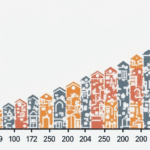Economic Condition at the End of Her First Year
As Claudia Sheinbaum, Mexico’s President, enters her second year of governance on October 1st, it is essential to examine the economic landscape she inherited and the challenges ahead.
Sheinbaum’s first year concluded with relative macroeconomic stability, albeit with anemic economic growth and intense fiscal pressures. The government managed to avoid a recession, but the economy remains stagnant.
Key Economic Indicators
- Inflation: 3.6% at the end of August; underlining persistent upward trend with a subyacente inflation of 4.1%
- Unemployment: 2.4% in December 2024, although low, it reflects high informality
- Private Consumption: -0.1% (by June), indicating a slowdown
- Fixed Investment: -6.4% (by June), showing contraction due to low public and private sector dynamism
- Trade Balance: with a surplus, but vulnerable to US tariffs
- Remittances: moderate growth
- Public Debt: projected at 51.4% by the end of 2025, increasing with potential risks to investment grade
Beyond direct economic factors, the reform of the judicial system and the reconstitution of Mexico’s Supreme Court are crucial for investor confidence.
Key Initiatives and Challenges
Sheinbaum’s second year begins with 5.3 billion pesos in tax revenues and a strong emphasis on social programs (483,000 million pesos for pensions of adults over 65).
- Low Consumer Confidence: At 52.74% in September, indicating cautious optimism
- Foreign Direct Investment: Nearly 90% in reinversions, not new investments
- Economic Growth and Trade Uncertainty: The semáforo is at amber due to low growth dynamism and external risks related to trade, as well as internal risks associated with the rule of law
Key challenges for Sheinbaum’s second year include maintaining macroeconomic stability, boosting economic growth, renegotiating the T-MEC, and reducing internal uncertainty.
Key Investments in Energy Sector
Amidst these economic challenges, Grupo Carso, led by Carlos Slim, has committed to financing Petróleos Mexicanos (Pemex) for the drilling and completion of 32 wells in the Ixachi field.
Ixachi is one of Mexico’s most significant onshore fields, currently producing around 93,000 barrels of oil and 715 million cubic feet of gas daily, totaling approximately 236,000 barrels of oil equivalent.
Through its subsidiaries GSM Bronco and MX DELTA NRG 1, Grupo Carso signed a contract with Pemex for Developed and Financed Drilling Services.
- Contract Details: Grupo Carso will receive its first payment in January 2027, funded by Pemex’s revenues from commercializable hydrocarbons derived from this allocation.
- Production Timeline: Pemex expects to have 12 of the up-to-32 wells in production by then.
- Drilling Duration: The drilling and completion of up to 32 wells will take place over three years.
- Bidding Process: Grupo Carso’s subsidiaries were the sole bidders for this contract.
Key Questions and Answers
- What is the economic condition at the end of Sheinbaum’s first year? The economy showed relative macroeconomic stability but stagnant growth with intense fiscal pressures.
- What are the key economic indicators? Inflation is 3.6%, subyacente inflation is 4.1%; unemployment is 2.4% with high informality; private consumption is -0.1%; fixed investment is -6.4%; trade balance has a surplus but is vulnerable to US tariffs; remittances show moderate growth; and public debt is projected at 51.4%.
- What are Sheinbaum’s key initiatives and challenges for her second year? Key initiatives include a strong focus on social programs. Challenges are maintaining macroeconomic stability, boosting economic growth, renegotiating the T-MEC, and reducing internal uncertainty.
- What significant investments are being made in the energy sector? Grupo Carso, led by Carlos Slim, has committed to financing Pemex for drilling and completing 32 wells in the Ixachi field. The first payment is due in January 2027, with an expected production of 12 wells by then.






